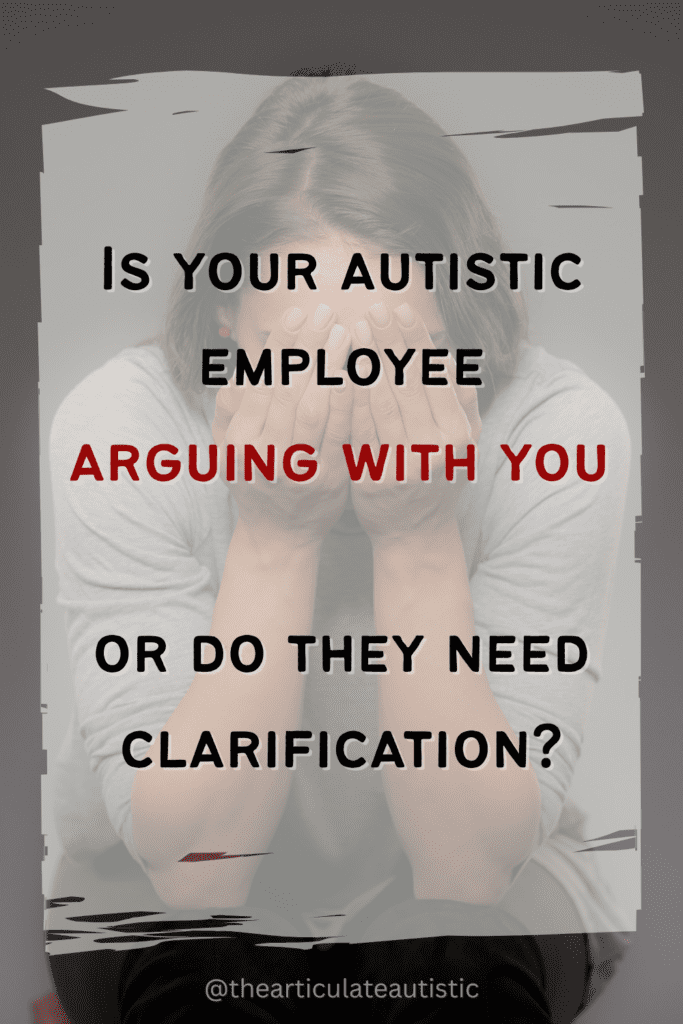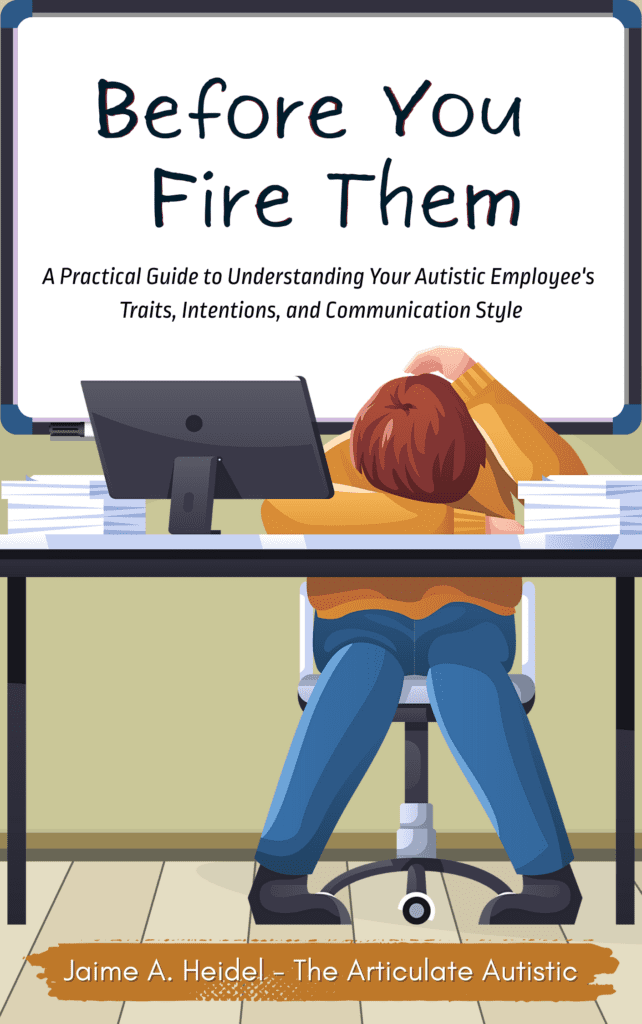“Why Does My Autistic Employee Argue With Me?”

You’re a manager sitting in your office with your door closed, lights dimmed, and your head in your hands. Feeling a tension headache coming on, you gently massage your temples while going over the heated discussion you just had with your autistic employee. This is the third time this week you’ve gotten into an argument with them! It’s getting ridiculous, and you’re seriously considering letting them go.
“Why can’t they just do what I tell them?” “Why does everything have to be a long, drawn-out discussion?” “Why does my autistic employee argue with me?”
Hi. I’m autistic, and I can explain.
As a neurotypical (non-autistic) person, you, the manager, often see questions, corrections, and “buts” from employees as purposeful challenges to your authority.
In your eyes, backtalk equals insubordination.
For your autistic employee, however, questions, corrections, and “buts” have a very different purpose, and that purpose is clarification. There’s no intent, let alone a thought of challenging your authority or questioning your leadership ability.
What they need and what they are asking for is more information.
“But why? Didn’t I already give them an overview of what I expect?”
You did. However, an overview may not be enough for your autistic employee. Let’s take a closer look at why.
Your Autistic Employee’s Thinking and Processing Style
To reframe your autistic employee’s motivations when they appear to argue with you, it’s important to understand how our thinking and processing style differs from that of your neurotypical employees.
- Bottom-up
Most neurotypical people have a top-down thinking and processing style, which means their brains automatically take what they’ve learned from previous experiences and apply it to new but similar situations. This is why, when they’re given an overview of expectations, as long as they’re somewhat familiar, they can carry them out.
Most autistic people, by contrast, have a bottom-up thinking and processing style, which means they learn by collecting small details and building them into the bigger picture of what’s expected. This can make transitioning from one job to another a bit more challenging since the full scope of expectations doesn’t automatically ‘transfer over’ to the new environment.
- Literal
In addition to being a bottom-up thinker and processor, autistic people tend to think literally rather than figuratively. Our brains prioritize the words others say rather than the non-verbal social cues that may accompany those words.
So, if you say, “I need you to do this,” but you meant the opposite, or you sent a non-verbal message with your words, your autistic employee is likely not going to pick up on it. They’re going to follow your exact words.
Autistic people often get into trouble for this because following instructions literally can be mistaken for sarcasm or malicious compliance.
If your autistic employee has worked in previous jobs where managers were unclear, they’ll be more likely to ask clarifying questions and correct something you said previously if it contradicts the words you’re saying now.
They’re not trying to undermine you; they just don’t want to be confused.
Example:
Tina, 45, autistic, has been working in a factory for the past few days. The manager gave her direct, step-by-step assembly instructions and encouraged her to write them down.
On the fourth day, when Tina’s manager checks in to see how things are going, she idly rehashes the assembly process, and while doing so, inadvertently reverses steps four and five.
Tina goes into instant fight-or-flight mode. She stares up at her boss, wide-eyed, mouth agape, half-assembled pieces now gripped in trembling hands.
Has she been doing it wrong this whole time? Did she misunderstand something? Is she going to be fired? Not again!
Tina blurts out, “B…but, you s…said I was supposed to do this step and then this step! Is that wrong? I did 500 pieces today alone, and–”
The manager, shocked by Tina’s outburst, takes a step back. She realizes the whole department is staring at them. “You know what I meant! Yes, step four and THEN step five. You’ve been doing this for days, and Quality Assurance hasn’t said anything. Of course, you’re doing it right!”
The manager stalks away, annoyed at being called out so loudly and publicly for a simple speaking mishap.
Who does Tina think she is? Where did that attitude come from all of a sudden? We’re going to have a serious talk about that!

Unfortunately, what the manager took for attitude and insubordination was fear on the part of an autistic employee who has both a bottom-up and literal thinking style. For one terrifying moment, Tina thought she had messed up thousands of pieces by accidentally reversing the steps.
Her quick, pattern-recognizing brain went into overdrive, picturing her dismissal before the manager even had a chance to finish her thought. Furthermore, in her moment of panic, Tina couldn’t even consider the possibility that her manager misspoke. Her literal brain took each word at face value.
The correction and question were an attempt to alleviate anxiety and gain clarification. However, Tina’s fear made her question sound like an accusation, even an admonishment, which upset the unspoken hierarchy between employer and employee.
Reduce Circular Conversations With Clear Communication
When you’re unfamiliar with the autistic neurotype, it can seem as though your employee is talking in circles on purpose. They continue bringing up the same points, and you explain them, but there’s still no clear resolution, and you both walk away frustrated.
You can reduce these circular conversations by front-loading clear, direct, step-by-step instructions and then following those instructions up with the same ones in written format.
Your autistic employee will still need to ask questions to collect and build on the details they need to form the whole picture.
However, over time, the sequence becomes a part of their routine, a part of their mental map, and they won’t need to ask for further clarification unless something changes.
The Takeaway
Clarifying questions can feel like attacks if you’re used to people using them disingenuously. Your autistic employee is not doing that. All they want is to perform their job effectively and avoid a write-up, performance plan, or dismissal.
(Which I’m sure you’d like to avoid, too!)
The next time your autistic employee appears to be arguing with you, take a deep breath, reframe their intention in your mind, and offer them clarification.
Not only will you provide accessibility for them, but more headache-free days for yourself!
My new book, Before You Fire Them: A Practical Guide to Understanding Your Autistic Employee’s Traits, Intentions, and Communication Style, will give you quick, at-a-glance explanations for common workplace miscommunication scenarios and immediate ways to resolve them.

This guide is an invaluable tool for managers and an excellent addition to your existing Human Resource Plan!
Looking for more purchasing options? I published through IngramSpark, which is distributing my book globally. The rollout for the paperback is slow, but the eBook is available in several other places. A quick Google search should help you find it in your area. 🙂


